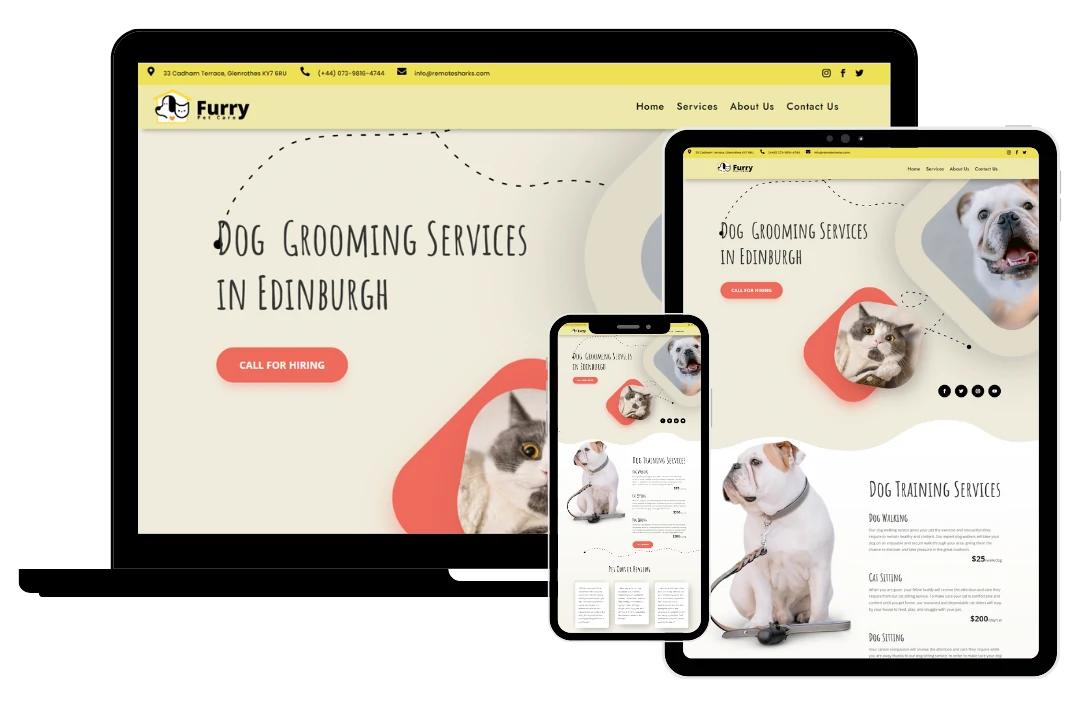TANSY
Dog Walker Website Template
Tansy is a charming WordPress template for dog walking services, featuring a friendly design that showcases your services and connects pet owners with ease.
Note: This design MUST be used with WORDPRESS. Photos are included.
VIEW DEMO
BUY NOW

Built on WORDPRESS Desktop Ready
Mobile Ready
About | How it Works | Add-Ons | FAQ
Built on WORDPRESS
Desktop Ready
Mobile Ready
About | How it Works | Add-Ons | FAQ

About Tansy
12+ Pages Included!
Home page
Services
About Page
Contact Page
404 Page
Thank You Page
Pet Sitting Services
Dog Walking Services
Pet Taxi Services
Bathing and Brushing
Haircuts and Styling
Nail Trimming Services
SEE ALL PAGES





![]()
“The Tansy template transformed my online presence! The design is simple and attractive, making it easy for clients to navigate and book my services.”
Mildred Hilda, Owner at Paws & Claws Dog Walking
Here’s What you Need to Know
We’ve spent hundreds of hours mastering website design and WordPress building so you don’t have to learn to do it all yourself—or pay someone the big bucks to do it for you!
![]() 4.8 | Trusted by Dog Walkers
4.8 | Trusted by Dog Walkers

Website Highlights
Optimized For Local Ranking Factors
Designed to rank well in local search results, so you can attract more customers in your area.
Sleek and Professional Design
First impressions matter. Look professional and inviting, and make a good impression on potential customers.
Work seamlessly on all devices
Work seamlessly on all devices, including desktops, laptops, tablets, and smartphones.
You’ll Need
✓ Domain
✓ Paid Hosting Plan
Design Details
You can easily change all colors, fonts, graphics, images, and text, add pages, and adjust the layout to suit your brand!
BUY NOW

![]()
“Tansy made creating my website a breeze! The layout is clean and professional, and I’ve received numerous compliments from clients about how easy it is to use.”
Jayden Eli, Owner at Happy Tails Dog Walking
Simple Steps to DIY your Success

USE QR TO VIEW THE MOBILE VERSION
01 CHOOSE YOUR FAV
Checkout with your fav template, and then you’ll get instant access via email to your template resources + guides!
02 YOU’VE GOT MAIL!
Your Divi license key will be delivered to your email within 24 hrs. Use this license key and enjoy the Divi lifetime updates!
03 DESIGN TIME
Add basics like your pages, logos & social accounts. Change text, colors, fonts. Use current images or replace them!
04 LAUNCH WEBSITE!
Work through the final launch to make sure everything’s on point. You launch in 5, 4, 3…. Congratulations!
05 POP THE BUBBLY!
Launch like a pro, pat yourself on the back, then get to the nearest happy hour! You built a freakin’ website!
BUY NOW
We’ll help you Launch this scroll-stopping WordPress Template. In less time than you think!
Love this template but it’s short on time. Don’t worry, We can help you set up your WordPress site with this template within 24 hours.

Plus… Tons of Bonuses Included!
With the extras included with our templates, you can launch your website quickly and in a beautiful way.




Template Add-Ons
Browse below to discover our template add-ons, perfect for taking your website to the next level. All add-ons are $15!

Matching Social Media Templates
Complete your brand with matching social media templates! Seamlessly integrate your website’s design across all platforms and launch your business effortlessly, ensuring a cohesive and professional online presence.
Marketing Plan
Maximize your website’s potential with our comprehensive marketing plan! Enhance your online strategy and drive traffic effortlessly, ensuring your business stands out and attracts the right audience.



![]()
“I love the Tansy template! It’s visually appealing and perfectly showcases my dog walking services. My clients appreciate how straightforward it is to find information.”
Isabella, Owner at Furry Friends Walks

VIEW DEMO
BUY NOW
Why choose WordPress for my website template?
WordPress templates offer a flexible and user-friendly platform for building websites.
With a vast selection of designs and functionalities, you can easily find a template that suits your specific needs and preferences.
Are WordPress templates customizable?
Yes! WordPress templates are highly customizable.
You can modify layouts, colors, fonts, and features to create a unique website that reflects your brand’s identity without needing extensive coding skills.
Is my WordPress website mobile-friendly?
Our WordPress templates are designed to be responsive, ensuring your website looks great on all devices, including desktops, tablets, and smartphones. This responsiveness enhances user experience and helps retain visitors.

Can I easily update my WordPress website?
Absolutely! WordPress allows you to easily update your content, images, and even the template itself. You can make changes whenever necessary to keep your site current and engaging for your audience.
